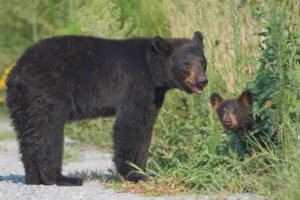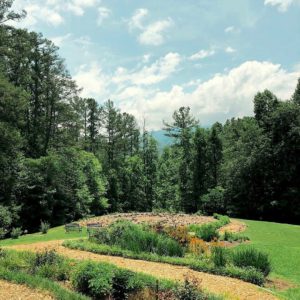July 30, 2018
“Throwback Thursday” for Buckhorn Inn 80th Anniversary
In 2018 Buckhorn Inn is celebrating our 80th anniversary with Throwback Thursday! Each Thursday in August our talented chef, Matthew Poole, will incorporate into the menu his modern take on some historical recipes. Innkeeper Lee Mellor is in possession of the original hand-written recipes used by our cooks in the 1930’s!
Desserts figured prominently in these early recipes. We found recipes for Fluffy Banana Cake, Texas Pecan Pralines, and Heavenly “Goo” topping for shortcake.
Savory recipes from 1938 include stuffed pork chops, roasted turkey and porcupine meatballs. Don’t worry– there is no porcupine meat in these meatballs! The name comes from the way rice grains poke out of the meatballs when they are done. The rice resembles the quills of these little animals, common in Israel. In Hebrew these meatballs are called Ktzizot Kipod.
Throwback Thursday Honors Long Culinary Tradition
The Buckhorn Inn opened its doors for business in August 1938. Many Knoxville residents visited this new Inn for lunch. Yes–in those days the Inn served three meals a day. Leisurely, plentiful lunches were a hallmark of the times. Douglas Bebb was passionate about the meals served at the Inn. He raised his own chickens to provide the very freshest eggs and his garden produced an abundance of fresh vegetables. He was an excellent cook and prepared all the meat dishes served at the Inn.

The ladies pictured here are Buckhorn Inn staff members Ella Huskey and Grace Price Branam (on the right). Mrs. Branam was the original cook for Buckhorn Inn.
The guests especially looked forward to the Sunday luncheon buffet. It was Mrs. Branam’s (the cook) day off, so Mr. Bebb cooked the meal in its entirety. He was rightfully famous for his corn pudding. In fact, his recipe was featured in the book Ford Times published by the Ford Motor Company to encourage driving vacations.
In those early days, a staff of four served the three meals a day. Tennessee was dry in those days, yet the pre-dinner cocktail hour was an honored tradition. The guests would simply bring their wine and spirits with them. Ellen Bebb, daughter of Douglas, reports that some of the guests would take turns hosting cocktail hours in the cottages. But the greatest honor was bestowed when guests were invited to Bebb House to share cocktails with their hosts.
Join us for a taste of history during dinners this August. Visit our website https://www.buckhorninn.com/dining/weekly-dining-menu to review our upcoming menus.
July 23, 2018
Amazing Biodiversity in the Great Smoky Mountains
The term “biodiversity” refers to the variety of plants, fungi, animals, and other organisms that can be found in a particular location. The Great Smoky Mountains is the most biodiverse park in the National Park System. The more than 800 square miles of the park contains more than 19,000 documented species. Some scientists believe an additional 80,000 to 100,000 species may be found here.
What are the Reasons for such Biodiversity?
According to the National Park Service, mountains, climate, and weather are the big reasons. http://www.nps.gov/grsm/learn/nature/index.htm The Smokies are among the oldest mountain ranges in the world. The plant-covered mountains were formed as long as 300 million years ago. Elevations in the park range from 850 to 6,643 feet. This range is similar to what one would find from Georgia to Maine. More than 95% of the park is covered with forest, much of it old-growth. The park is home to 100 species of native trees. The abundant rainfall and high humidity provide good growing conditions. It is interesting to note that the relative humidity in the Smokies in the summertime is about twice that of the Rocky Mountain region.
The north/south positioning of the Appalachian chain allowed the Smokies to become a home for many plants and animals that sought refuge from the glaciers of the last ice age. More than 1,500 flowering plant species have been identified in the Great Smoky Mountains National Park. Scientists report that the park also is home to more than 200 bird species, 68 species of mammals, 67 native fish species, 39 species of reptiles, and 43 species of amphibians.
The University of Tennessee has worked with the Great Smoky Mountains National Park to create the Species Mapper. The Species Mapper uses information from observations and research studies to predict where various species may be found in the Park. As more observations are added to the model, it becomes more accurate.
We will use this blog space to share an occasional series of articles focusing on the amazing biodiversity of our area.
July 16, 2018
New Breakfast Dish Tantalizes Guests’ Taste Buds
If you have stayed at the Buckhorn Inn, you know that breakfast is truly a highlight. Each morning we offer fresh coffee, biscuits and coffee cake right from the oven, fresh fruit, and a choice of a sweet or savory hot entrée. One of our newest breakfast dishes is chicken and waffles!
Not Just for Breakfast
Chicken and waffles is truly an American dish that draws both on soul food and Pennsylvania Dutch cuisine traditions.
There are several theories about the origins of this dish. We do know that European colonists brought waffles to America in the 1600’s. When Thomas Jefferson bought a waffle iron in France in 1789, the popularity of the dish soared. One origin theory says that in the early 1800’s Philadelphia restaurants served waffles with fried catfish. Chicken gradually became more popular than catfish because it was available year round. The Pennsylvania Dutch enjoyed Sunday dinners of waffles, chicken and gravy. So much so that the dish became a symbol of Pennsylvania Dutch country by the end of the 19th century.
In the early 20th century Harlem, New York, chicken and waffles was served by such restaurants as Tillie’s Chicken Shack, Dickie Wells’ jazz nightclub, and the Wells Supper Club. In 1935 Bunny Berigan composed a jazz instrumental called “Chicken and Waffles”. https://en.wikipedia.org/wike/Chicken_and_waffles
Fried chicken and waffles came to Los Angeles by 1940’s. The dish was served at The Maryland and marketed as a Southern specialty. Interestingly, the combination of chicken and waffles does not appear in early Southern cookbooks.
Whatever the origins of the dish, chicken and waffles has become a popular breakfast item at Buckhorn Inn. We make a light, fluffy waffle, top it with crispy fried chicken, drizzle it with a bit of Tennessee honey, and serve warm maple syrup on the side. What could make a better breakfast?
July 9, 2018
Black Bears in the Smokies
The Great Smoky Mountains National Park is a large, protected area where black bears can roam freely. The park service estimates that about 1,500 bears live in the park–that translates to a density of about two of the animals per square mile. Sighting one of these magnificent creatures is a highlight of a vacation, but caution is necessary for the protection of the bear and of the tourist. Bears can live 12-15 years or more in the wild, but those which have had access to human food and garbage have a life expectancy of only half that time.

Black bear (Ursus americanus) mother standing in the road with young cub peeking out from the bushes.
Behavior of Bears
Like us, bears are omnivores. Berries and nuts make up about 85% of their diet. Insects and carrion are valuable sources of protein. These creatures have a very keen sense of smell. Feeding bears, or allowing them access to human food and garbage causes a number of problems. It causes them to lose their instinctive fear of humans. Over time this means they may begin approaching people and may become more unpredictable and dangerous. They may begin to pose a risk to public safety and must be euthanized. In other cases they come close to human areas and are hit by cars or become easy targets for poachers. The park service warns us that Garbage Kills Bears!
What Do I Do If I See Bears?
They are beautiful creatures. But remember that they have color vision, a keen sense of smell, are good swimmers and tree climbers, and can run 30 miles per hour. The park service provides a short video to help tourists understand what to do if they see a bear http://www.nps.gov/grsm/learn/nature/black-bears.htm If you do see a bear you should remain watchful and not approach it. Do not allow the bear to approach you. Being too close may promote aggressive behavior from the bear. For these reasons, willfully approaching within 50 yards (150 feet) or any distance that disturbs or displaces a bear, is illegal in the park. Use binoculars or a telephoto lens to view them.
If the bear approaches you, don’t run but rather back slowly away. The bear will probably do the same. If he continues to approach you, change your direction. If he continues, stand your ground and talk loudly or shout at it. Make yourself look as large as possible. Use a stout stick to intimidate the bear. It is very rare that you would be physically attacked, but if so you should not play dead. Fight back aggressively with any available object.
Remember, the goal of bear management is to keep these magnificent animals shy, secretive, and afraid of people.
July 2, 2018
Guests Find Inner Harmony on Labyrinth Path
Whether you are seeking inner meditative peace, or just a nice walk, following the path of a meditation labyrinth may be for you. The Buckhorn Inn “Rachael’s Labyrinth” is named for Innkeeper Rachael Young. The path is constructed of local fieldstone and is encircled with native wildflowers and plants. Our labyrinth is of the medieval style.
Path for All Faiths
Labyrinths were in use long before recorded history. They all feature a single path that leads into the center of a space and then back out. Most cultures have a type of labyrinth. They have been associated with mini-pilgrimages and walked to reinforce protection, to bring good fortune, or to overcome difficulty. Today’s labyrinths offer the opportunity for meditation and slight concentration. Every journey is a personal one–everyone gets something different from the walk. The world-wide labyrinth locator http://www.labyrinthlocator.com lists 4,977 labyrinths in 80 countries, including the one at Buckhorn Inn in Gatlinburg, Tennessee! The Smithsonian Magazine highlights six labyrinths which have been heralded for their beauty and history.
The Chartres Cathedral in Chartres, France dates back to the year 1205. According to the magazine, scholars believe that the path symbolizes “the human journey from sin to redemption”.
When you walk through the Old Summer Palace in Beijing, China, you are walking through a structure built in 1709. The path is housed in a garden called the Garden of Perfection and Light. The 864-acre property was intended to be a private garden for Chinese emperors, but was destroyed by the British and French forces in the 1860s. The remaining ancient landscaping is like nothing anywhere else.
Dunure Castle in Scotland was a 13th century stronghold. The stone labyrinth is on the beach near a park and offers walkers a wonderful view of both the sea and the castle’s remains.
Lands End, San Francisco was built by artist Eduardo Aguilera in 2004. The labyrinth is located on a rocky outcropping overlooking the Golden Gate Bridge. The path is tucked away from view.
Do you enjoy walking labyrinths? Please share your pictures and stories. We would like to feature them in a future blog post.








Gatlinburg Weather
Click for weather forecast